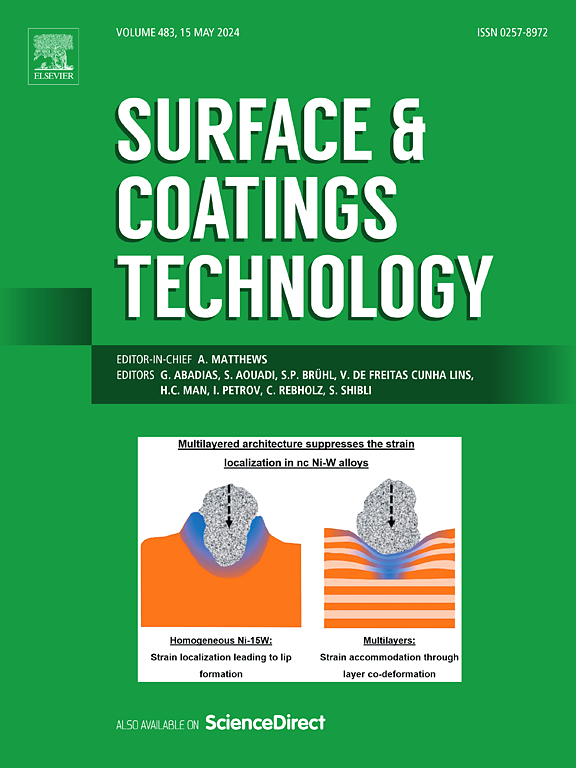Formation of corrosion-resistant coatings on cast AZ91D magnesium alloy using pulse electrolysis and the importance of coating morphology
IF 5.3
2区 材料科学
Q1 MATERIALS SCIENCE, COATINGS & FILMS
引用次数: 0
Abstract
Pulse electrolysis was conducted in a 3 M KOH-0.21 M Na3PO4-0.15 M Al(NO3)3-0.6 M KF solution to form a corrosion-resistant coating on a cast AZ91D magnesium alloy. We investigated the effect of the pulse repetition frequency (2, 5, and 10 kHz) on the chemical composition, morphology, and corrosion performance of the coating. While the chemical compositions of the coatings were similar, the coating morphology varied with the repetition frequency. The coating on the 5 kHz specimen exhibited a thickness of up to approximately 46 μm without delamination, whereas the coatings on the 2 and 10 kHz specimens were thinner. The coating on the 10 kHz specimen contained many cracks, and delamination from the alloy substrate was observed. In 0.01 M NaCl (pH 8.0), the open circuit potential of the 5 kHz specimen remained at approximately −0.2 V, even though that of the 2 and 10 kHz specimens oscillated at approximately −1.4 V. Potentiodynamic polarization tests revealed that the coating on the 5 kHz specimen inhibited both anodic and cathodic reactions, exhibiting a passive state from approximately −0.5 V to 0.5 V. The superior corrosion resistance of the 5 kHz specimen was attributed to the greater coating thickness and the absence of delamination from the substrate.
脉冲电解铸造AZ91D镁合金耐腐蚀镀层的形成及镀层形貌的重要性
在3 M KOH-0.21 M Na3PO4-0.15 M Al(NO3)3-0.6 M KF溶液中进行脉冲电解,在铸态AZ91D镁合金表面形成耐腐蚀涂层。我们研究了脉冲重复频率(2、5和10 kHz)对涂层化学成分、形貌和腐蚀性能的影响。虽然涂层的化学成分相似,但涂层的形貌随重复频率的变化而变化。在5 kHz条件下,涂层厚度可达约46 μm,且无分层现象,而在2和10 kHz条件下,涂层厚度较薄。在10khz试样上,涂层存在大量裂纹和合金基体脱层现象。在0.01 M NaCl (pH 8.0)中,5 kHz样品的开路电位保持在−0.2 V左右,而2和10 kHz样品的开路电位振荡在−1.4 V左右。动电位极化测试表明,涂层在5khz试样上抑制了阳极和阴极反应,在约−0.5 V至0.5 V范围内呈现钝化状态。5 kHz试样的优异耐腐蚀性归因于较大的涂层厚度和基材的无分层。
本文章由计算机程序翻译,如有差异,请以英文原文为准。
求助全文
约1分钟内获得全文
求助全文
来源期刊

Surface & Coatings Technology
工程技术-材料科学:膜
CiteScore
10.00
自引率
11.10%
发文量
921
审稿时长
19 days
期刊介绍:
Surface and Coatings Technology is an international archival journal publishing scientific papers on significant developments in surface and interface engineering to modify and improve the surface properties of materials for protection in demanding contact conditions or aggressive environments, or for enhanced functional performance. Contributions range from original scientific articles concerned with fundamental and applied aspects of research or direct applications of metallic, inorganic, organic and composite coatings, to invited reviews of current technology in specific areas. Papers submitted to this journal are expected to be in line with the following aspects in processes, and properties/performance:
A. Processes: Physical and chemical vapour deposition techniques, thermal and plasma spraying, surface modification by directed energy techniques such as ion, electron and laser beams, thermo-chemical treatment, wet chemical and electrochemical processes such as plating, sol-gel coating, anodization, plasma electrolytic oxidation, etc., but excluding painting.
B. Properties/performance: friction performance, wear resistance (e.g., abrasion, erosion, fretting, etc), corrosion and oxidation resistance, thermal protection, diffusion resistance, hydrophilicity/hydrophobicity, and properties relevant to smart materials behaviour and enhanced multifunctional performance for environmental, energy and medical applications, but excluding device aspects.
 求助内容:
求助内容: 应助结果提醒方式:
应助结果提醒方式:


